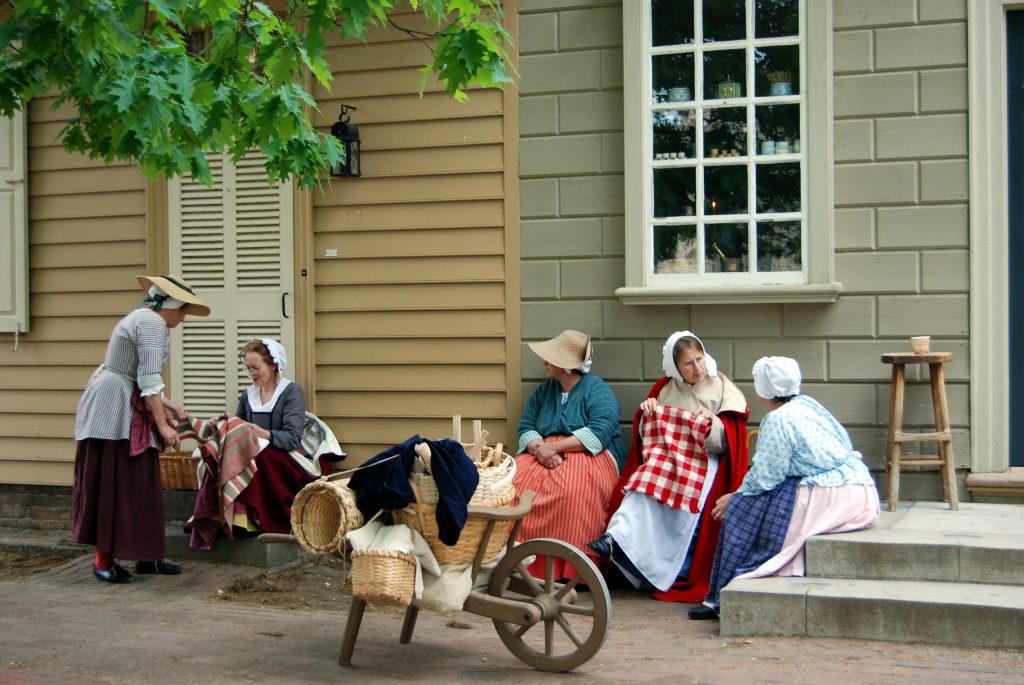Georgetowners are fortunate to live in a neighborhood steeped in the nation’s heritage. Some colonial and Revolutionary sites are right around the corner; others are short drives or train rides away. But few places can transport 21st-century families so purely into 18th-century America as Williamsburg, capital of Virginia from 1699 to 1780.
Almost the entire colonial town has been restored, house by house (by shop by barn by inn by courthouse). Even the Governor’s Palace, the splendid official residence of the Royal Governors of the Colony of Virginia, has been recreated, its entry-hall decorated in the traditional manner with rows of muskets and pistols.
Colonial Williamsburg’s restoration began in 1907, when William Archer Rutherfoord Goodwin determined to save crumbling Bruton Parish Church, where he was rector. But then his vision grew. In 1923, he gained the interest and major financial support of oil heir and philanthropist John D. Rockefeller Jr. and his wife Abby, whose goal became to restore the colonial capital in its entirety. Today, the open-air, living-history museum comprises 301 acres.
Throughout the historic area, reenactors are engaged in the everyday life of the period. Wearing colonial dress, they answer questions from visitors in the context of the times.
Owned and run by a widow whose father had been an innkeeper, Christiana Campbell’s Tavern also hosted lively meetings and balls of the Williamsburg Masonic Lodge in the 1770s. Today, trained reenactors loosely tie huge napkins around diners’ necks to protect their clothes (a tradition that should perhaps be revived) and set the table with pewter cutlery, brass candlesticks and dishes with 18th-century patterns. They describe how the spoon-bread appetizer is made, along with Washington “Salet” (ingredients: pickled beets, oranges, roasted pistachios and sheep’s milk cheese, served with sweet-potato muffins).
Ox carts and horse-drawn carriages take visitors along the blocks of craftsmen’s shops, displaying replicas of 18th-century clothes, hats, tools, glassware and even books that were made in the area or imported from England. Courthouse trials are recreated, as are the goings-on at the Governor’s Palace when the British governor was driven away by revolutionaries like Patrick Henry. African American reenactors talk about the lives of enslaved and free blacks, describing how African heritage influenced the Colonial way of life and how blacks contributed to the Revolution.
Colonial Williamsburg offers the chance to fully experience the past, but the surrounding city of Williamsburg (pop. about 15,000) has become a thriving community of students, families and senior citizens. It is an easy stroll from the historic area to the modern community of Williamsburg, which boasts sidewalk cafes, shops, restaurants and professional offices, as well as the city government and community services.
At one end of the historic area is the beautiful campus of the College of William and Mary, the second-oldest institution of higher education in the United States. Established in 1693, it is the only one of the nine colleges founded in the colonial era located in the Southern states. With about 8,500 students, William and Mary remains one of the nation’s preeminent small colleges.
“Williamsburg is a perfect place to retire,” said Ellie Thuermer, enthusiastically downing coffee and cake outside a café at 9 p.m. on a pleasant June evening. Thuermer is an 89-year-old Ohioan who moved to Williamsburg 12 years ago to become involved with Colonial Williamsburg. “I loved volunteering in one of the Colonial homes and meeting people from all over the world,” she said. She still drives and often attends classes in history, religion and the arts offered by William and Mary’s Christopher Wren Association for Lifelong Learning. Life as a Williamsburg resident is affordable for seniors, reports Thuermer, thanks to the tourism-supported local economy.
Some four million tourists come to the area each year to visit the Historic Triangle: Williamsburg, Jamestown — the first British colonial settlement in America — and Yorktown, where the last major battle of the American Revolution was fought and won. In and around the historic sites and parkways are hotels, golf resorts, shopping malls and even a water park for when the young tire of historic activities (the ox cart is really, really slow).
But at Colonial Williamsburg, children can be seen excitedly playing with wooden tops, learning to fire flintlock muskets at the outdoor market on the green, even begging their parents to buy them a bonnet and a soldier’s hat. The living history seeps in as they lick early American candy, watch a horse being shod and, yes, even experience the ox cart’s relaxed — not to say plodding — pace.


